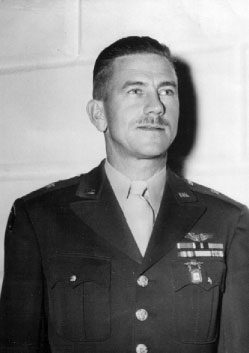Brig. Gen. William Wallace Ford
was enshrined in 2007
was enshrined in 2007

Born in Waverly, Va., and a Field Artilleryman at his graduation from the U.S. Military Academy in 1920, William Ford was a longtime aviation enthusiast who flew his own civilian aircraft (he soloed at Ft. Bliss, Texas in 1933). During 1936-39 he served as member of the ROTC staff, Field Artillery, at Eastern Kentucky University in Richmond. By 1940 he earned his Commercial Pilot and Instrument Ratings. During this time he kept his private light aircraft at the old Cool Meadow airport in Lexington. As a pilot he was one of the first to recognize the practicality of each artillery unit of having its own light aircraft which could move right along with each battery and give full-time air spotting service for artillery. He envisioned the use of light aircraft in providing an "Air Observation Post" for artillery fire adjustment, and his authorship of a thought-provoking article in the May 1941 issue of the "Field Artillery Journal," entitled "Wings for Saint Barbara," focused attention on his advanced thinking. Shortly thereafter, he sought the efforts of the light airplane industry to prove the utility of its products. Ford's penetrating articles led to War Department approval of an experimental program to train artillerymen to fly and to adjust artillery fire from light planes.
Drawing upon industry and government for flight and maintenance instructors, Ford then organized and directed a course which - in its radical departure from conventional techniques - produced Artillery Liaison pilots who were freed from their dependence upon established airfields, and who were able to operate from field strips and rough areas alongside the Artillery units of which they were a part. Successful demonstrations to field units in the spring of 1942 proved the validity of this novel concept, and on 6 June 1942 the War Department authorized a permanent Department of Air Training, later to evolve into today's Army Aviation School.
Ford became the first director of air training at Fort Sill, OK, training a group of licensed pilots in the techniques of aerial artillery spotting from small aircraft. Training began at Fort Sill's Post Field with 24 Piper Cub J-3 airplanes furnished by the AAF. The students at the first class, who have come to be known as "Class Before One," consisted of both officers and enlisted men. At Fort Sill, they were trained in both tactical flying and airplane maintenance. For artillery spotting, they had to learn to fly low to avoid hostile aircraft and fly slow to land on the shortest possible landing strip. The success of these "Liaison Pilots," a direct outcome of William Ford's vision and abilities, paved the way for the subsequent development of Army Aviation as it is known today. Considered by many to be the "Father of Army Aviation," William Wallace Ford was inducted into the Army Aviation Hall of Fame in 1975. A building complex at the Army Aviation Training Center, Ft. Rucker, Ala., was memorialized as Ford Hall in September 1990.
